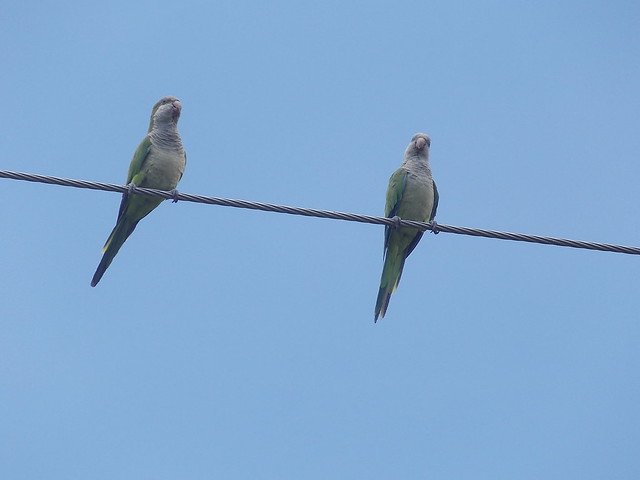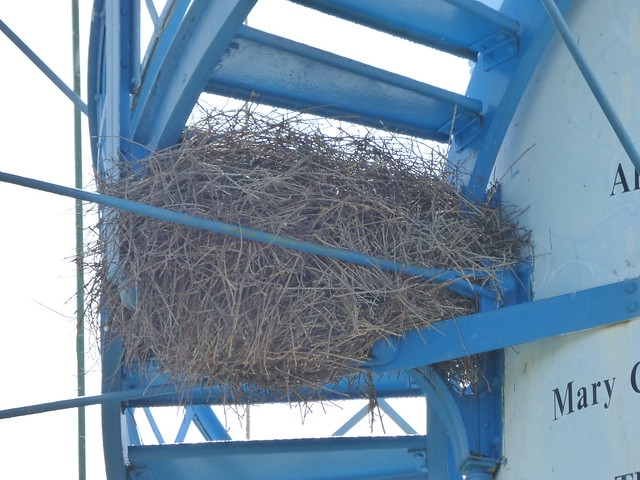We had a delightful time today with Nancy and Charlie Hinman. We went to lunch at Berry Fresh here in Stuart.
Hey...what happened to Charlie??? Oh well! I can tell you Charlie had the cheese stuffed pancakes and I had the Monte Cristo sandwich. Boy was it good!!
After stuffing ourselves we headed over to Sandsprit Park at the entrance to Manatee Pocket on the ICW. Here we found a colony of wild parrots and some wonderful scenery on a very breezy day.
And here is Charlie!
I got a few bird photos:
Here is some info on these creatures:
"The Monk Parakeet, also known as the Quaker Parrot, is colorful, sociable, and highly intelligent, which makes it a popular part of the pet trade. And that is how it came to Florida.
"Florida's Invaders" is a diary series exploring the non-native plants and animals of the Sunshine State.

The Monk Parakeet, Myiopsitta monachus, is one of the smaller members of the parrot family. Standing about a foot tall, these parrots are a bright electric green with splashes of yellow and blue, and greyish on the chest. They look very similar to the introduced Nanday Parakeet, but lack that bird's distinctive black head. In the wild, they are found in dry areas in Brazil, Bolivia, Uruguay and Argentina. The birds form gregarious flocks that live in large communal nests. Unlike most parrots, which eat mostly seeds, the Monks also eat large amounts of fruit and berries, as well as insects. As the pampas grassland areas in South America were planted with fruit orchards by humans, the birds found perfect habitat and moved in, becoming a serious agricultural pest. In some areas up to 40% of a fruit orchard's yield may be lost to the marauding parrots.
In the 1960s, the Monk Parakeet became enormously popular in the exotic bird trade, prized for its small size, its intelligence, and its skill in learning to talk. By 1968 some 16,000 birds were being taken from the wild and imported to the US each year. By the time the trade in wild birds was restricted, some 65,000 Monk Parakeets had been brought in.
Inevitably, there were escapes; the birds found North America's suburban parks, golf courses, and lawns to their liking, and it wasn't long before feral colonies became established, even in cold northern cities like New York and Chicago (in their native South America they often live in the Andes foothills, and are thus adapted to tolerate colder temperatures than most parrots can stand). In the American south, the Monks are able to make a living from fruit trees and shrubs; in the north, they depend on human birdfeeders to get through the winter.
The USFWS made a brief attempt to eradicate the non-natives and was temporarily successful in removing colonies in California, but it soon became apparent that the effort was futile. Within a few years, Monk Parakeet colonies could be found in New York, Connecticut, Illinois, California, Texas, Louisiana, Oregon, New Jersey, and Alabama. The first nesting colonies were seen in Florida in 1969. Today, there are established populations in over 50 counties, including Tampa, St Petersburg, Jacksonville, Bradenton, Ft Lauderdale, Miami, and Boca Raton. Flocks of the bright green birds can often be seen flying overhead or covering lawns looking for seeds and bugs. The parrots keep in contact with each other through constant screeches and squawks, and flocks can usually be heard from quite a distance away. A number of individuals serve as sentinels, watching out for hawks or other dangers.
So far, the Monk Parakeet's effect on Florida has been minimal. The feral flocks have preferred to stay in the urban areas and have not moved into the rural agricultural regions, where they have the potential to become a serious economic pest. In the cities they do not appear to be having a negative impact on native birds, instead filling the ecological niche that has been empty since its American relative the Carolina Parakeet became extinct. It is estimated that about 35,000 Monk Parakeets now live in Florida.
The bird does have one habit, however, which has made it a serious annoyance to city governments all over Florida. Unlike most parrot species, which nest individually in tree cavities, Monk Parakeets make huge communal nests, woven from twigs and grass stems, which can contain hundreds of birds. These resemble a large section of thatched roof, sometimes ten feet across, and can weigh several hundred pounds. The small number of entrances (usually at the bottom) prevents snakes and other predators from entering, while the thick insulation provides warmth in the winter, and contains a honeycomb of interior chambers for egg-laying. In the wild, these nests are constructed in tall trees, but in the city, the Monk's favorite spots are urban utility poles.

"Electricity" and "dry twigs" don't go together very well, and it is not unusual for the nests to catch fire, roasting all the birds, destroying the electric lines, and cutting off power to the neighborhood. And during Florida's frequent rainstorms, wet twigs can also short-circuit the power lines, with the same result. And so Florida's electric companies have declared war on the Monk Parakeet. Every so often, the power company will come by and knock down the entire nest. The now-homeless birds will in turn quickly rebuild it. It then becomes a contest of will and endurance, and since the city is prevented from killing the parrots by the potential public outcry from bird-lovers everywhere, the Monks always win. And for many people, the birds, though non-native, are a welcome addition, adding some color and sound to their city life."
This content was created by a Daily Kos Community member.
We had a great afternoon with some people we really like. Thank you Nancy and Charlie! Life is good!








No comments:
Post a Comment